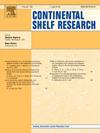海洋聚囊球菌的分子组成特征反映了陆架海高度的环境异质性
IF 2.2
3区 地球科学
Q2 OCEANOGRAPHY
引用次数: 0
摘要
聚球菌是海洋光合浮游植物的优势类群,在陆架海洋的初级生产力和碳循环中起着至关重要的作用。其分布格局对环境变化高度敏感,是评估生态系统对气候变化和人为压力响应的重要指标。然而,在渤海和黄海中,聚珠球菌的遗传多样性与环境异质性之间的关系尚未得到充分的探讨。本研究采用高通量测序方法对渤海和黄海聚囊球菌的系统发育和表型多样性进行了研究,揭示了不同典型生境下聚囊球菌的不同基因型组成。在系统发育分布上,S5.1支I和S5.1支VI在渤海地区占主导地位,平均占25.47%和26.20%;黄海以ⅰ支和ⅱ支为主,分别占47.72%和14.82%。表型上,渤海地区以2型为主,占53.15%;黄海以3a型和3dA型为主,分别占49.51%和40.88%。温度和盐度是影响聚珠球菌分布模式的关键环境制约因素。在亚群水平上,演化枝IX和3dA型的分布与盐度密切相关,而3a型主要受溶解氧的影响。这些发现强调了聚珠球菌的分布模式与环境特性之间的显著相关性,这进一步得到了聚类结果的支持,通过主成分分析获得了相似的模式。这些发现突出了基于聚珠球菌分子标记的空间生态位分析在反映陆架海环境变化方面的应用潜力。未来的研究应集中于阐明聚球菌分布模式的分子调控机制,从而为了解陆架生态系统中关键物种对环境胁迫的响应提供重要基础。本文章由计算机程序翻译,如有差异,请以英文原文为准。

Molecular composition characteristics of marine Synechococcus reflect the highly environmental heterogeneity in the shelf seas
Synechococcus, a dominant group of marine photosynthetic picophytoplankton, play a crucial role in primary productivity and carbon cycling within shelf seas. Its distribution patterns are highly sensitive to environmental changes, rendering it a valuable indicator for assessing ecosystem responses to both climate change and anthropogenic pressures. Nonetheless, the relationships between the genetic diversity of Synechococcus and environmental heterogeneity in the Bohai Sea and Yellow Sea have not been thoroughly explored. Here, we employed the high-throughput sequencing method to investigate the phylogenetic and phenogenetic diversity of Synechococcus in the Bohai and Yellow seas, revealing distinct genotype compositions depending on typical habitats. Regarding phylogenetic distribution, both S5.1 clades I and VI dominated in the Bohai Sea with an average proportion of 25.47 % and 26.20 %, respectively; while clades I and II became predominant in the Yellow Sea accounting for 47.72 % and 14.82 %, respectively. Phenogenetically, type 2 dominated in the Bohai Sea occupying 53.15 %; types 3a and 3dA were dominant in the Yellow Sea accounting for 49.51 % and 40.88 %, respectively. Temperature and salinity were identified as key environmental constraints influencing the distribution patterns of Synechococcus. At the sub-group level, clade IX and type 3dA showed distributions closely related to salinity, whereas types 3a were primarily influenced by dissolved oxygen. The findings underscored the significant correlations between the distribution patterns of Synechococcus and environmental properties, which were further supported by cluster results demonstrating similar patterns obtained through principal component analysis. These findings highlight the application potential of spatial niche analysis based on Synechococcus molecular markers in reflecting environmental changes in shelf seas. Future studies should focus on elucidating the molecular regulatory mechanisms governing the distribution patterns of Synechococcus, thereby providing a critical foundation for understanding the responses of keystone species to environmental stresses in shelf ecosystems.
求助全文
通过发布文献求助,成功后即可免费获取论文全文。
去求助
来源期刊

Continental Shelf Research
地学-海洋学
CiteScore
4.30
自引率
4.30%
发文量
136
审稿时长
6.1 months
期刊介绍:
Continental Shelf Research publishes articles dealing with the biological, chemical, geological and physical oceanography of the shallow marine environment, from coastal and estuarine waters out to the shelf break. The continental shelf is a critical environment within the land-ocean continuum, and many processes, functions and problems in the continental shelf are driven by terrestrial inputs transported through the rivers and estuaries to the coastal and continental shelf areas. Manuscripts that deal with these topics must make a clear link to the continental shelf. Examples of research areas include:
Physical sedimentology and geomorphology
Geochemistry of the coastal ocean (inorganic and organic)
Marine environment and anthropogenic effects
Interaction of physical dynamics with natural and manmade shoreline features
Benthic, phytoplankton and zooplankton ecology
Coastal water and sediment quality, and ecosystem health
Benthic-pelagic coupling (physical and biogeochemical)
Interactions between physical dynamics (waves, currents, mixing, etc.) and biogeochemical cycles
Estuarine, coastal and shelf sea modelling and process studies.
 求助内容:
求助内容: 应助结果提醒方式:
应助结果提醒方式:


